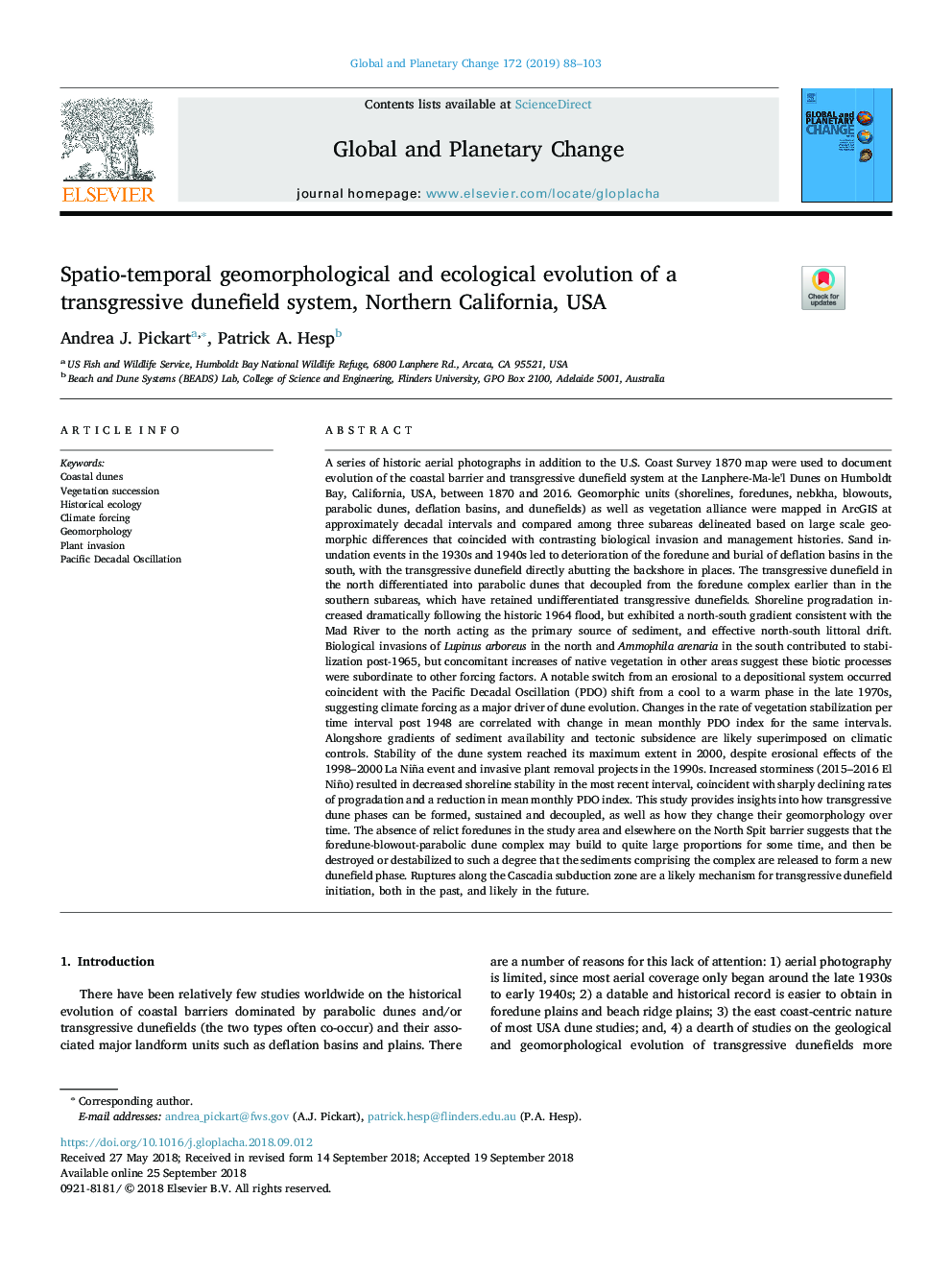| کد مقاله | کد نشریه | سال انتشار | مقاله انگلیسی | نسخه تمام متن |
|---|---|---|---|---|
| 11025023 | 1701038 | 2019 | 16 صفحه PDF | دانلود رایگان |
عنوان انگلیسی مقاله ISI
Spatio-temporal geomorphological and ecological evolution of a transgressive dunefield system, Northern California, USA
دانلود مقاله + سفارش ترجمه
دانلود مقاله ISI انگلیسی
رایگان برای ایرانیان
کلمات کلیدی
موضوعات مرتبط
مهندسی و علوم پایه
علوم زمین و سیارات
فرآیندهای سطح زمین
پیش نمایش صفحه اول مقاله

چکیده انگلیسی
A series of historic aerial photographs in addition to the U.S. Coast Survey 1870 map were used to document evolution of the coastal barrier and transgressive dunefield system at the Lanphere-Ma-le'l Dunes on Humboldt Bay, California, USA, between 1870 and 2016. Geomorphic units (shorelines, foredunes, nebkha, blowouts, parabolic dunes, deflation basins, and dunefields) as well as vegetation alliance were mapped in ArcGIS at approximately decadal intervals and compared among three subareas delineated based on large scale geomorphic differences that coincided with contrasting biological invasion and management histories. Sand inundation events in the 1930s and 1940s led to deterioration of the foredune and burial of deflation basins in the south, with the transgressive dunefield directly abutting the backshore in places. The transgressive dunefield in the north differentiated into parabolic dunes that decoupled from the foredune complex earlier than in the southern subareas, which have retained undifferentiated transgressive dunefields. Shoreline progradation increased dramatically following the historic 1964 flood, but exhibited a north-south gradient consistent with the Mad River to the north acting as the primary source of sediment, and effective north-south littoral drift. Biological invasions of Lupinus arboreus in the north and Ammophila arenaria in the south contributed to stabilization post-1965, but concomitant increases of native vegetation in other areas suggest these biotic processes were subordinate to other forcing factors. A notable switch from an erosional to a depositional system occurred coincident with the Pacific Decadal Oscillation (PDO) shift from a cool to a warm phase in the late 1970s, suggesting climate forcing as a major driver of dune evolution. Changes in the rate of vegetation stabilization per time interval post 1948 are correlated with change in mean monthly PDO index for the same intervals. Alongshore gradients of sediment availability and tectonic subsidence are likely superimposed on climatic controls. Stability of the dune system reached its maximum extent in 2000, despite erosional effects of the 1998-2000 La Niña event and invasive plant removal projects in the 1990s. Increased storminess (2015-2016 El Niño) resulted in decreased shoreline stability in the most recent interval, coincident with sharply declining rates of progradation and a reduction in mean monthly PDO index. This study provides insights into how transgressive dune phases can be formed, sustained and decoupled, as well as how they change their geomorphology over time. The absence of relict foredunes in the study area and elsewhere on the North Spit barrier suggests that the foredune-blowout-parabolic dune complex may build to quite large proportions for some time, and then be destroyed or destabilized to such a degree that the sediments comprising the complex are released to form a new dunefield phase. Ruptures along the Cascadia subduction zone are a likely mechanism for transgressive dunefield initiation, both in the past, and likely in the future.
ناشر
Database: Elsevier - ScienceDirect (ساینس دایرکت)
Journal: Global and Planetary Change - Volume 172, January 2019, Pages 88-103
Journal: Global and Planetary Change - Volume 172, January 2019, Pages 88-103
نویسندگان
Andrea J. Pickart, Patrick A. Hesp,